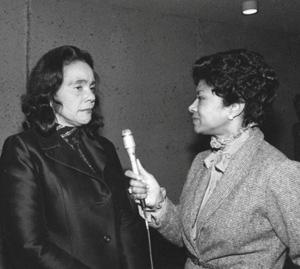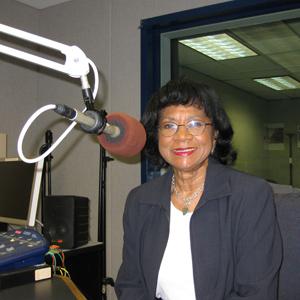Through the first half of the 20th century, as television became a fixture in US homes, the reporters Americans saw on TV were white, and almost all men. That began to change in the 1960s. African-American Belva Davis was at the forefront of that shift.
(Sound)
For thousands of TV viewers in the San Francisco Bay Area, Belva Davis is a trusted, familiar face on the evening news. But, she recalls, while she was growing up, there were rarely black faces on TV.
"When I was a kid at home, we used to yell, 'Come look, come look. There's a colored man on television.' And the whole family would stop and we'd come to get a little glimpse of whoever that person of color was." says Davis. "Well, my goodness, if you did that now, you'd be exhausted by the end of the day."
Early years
Davis is one of the reasons American television now reflects the racial and ethnic diversity of the country. She grew up in a dirt poor family in Louisiana in the 1930s, a place and a time in which segregation and discrimination were rampant.
Things weren't much different when her family moved west, when Davis was still in school.
"We arrived in California expecting milk and honey, was not at all so." she recalls. "Just being disliked by so many people who didn't like our accents, didn't like our names, just didn't like very much about us because we were so different."

Challenging times
Davis began her career writing for Jet, a black magazine, before moving on to radio. She remembers the early years as pretty tough.
"All my experience, the majority of it was working in totally segregated media. I could only work at stations that were programmed especially for black people. I could only write for newspapers that were published for a black audience. And no one else would give me even a decent (job) interview for many years."
But Belva Davis persevered. She was among the first to break the color barrier when she was hired by a San Francisco TV station in 1967. As the first woman of color in the newsroom, Davis was seen as an oddball and many of her colleagues thought she would only last two weeks on the job.
At that time, Davis says, society at large wasn't ready for a black female TV reporter. She recalls encountering hostility and skepticism.
Breaking in
"I was working, doing the City Hall beat, and I wasn't allowed in the press room. I couldn't even put a telephone in the press room. And when I was asked to leave news conferences, because they'd say 'This is for reporters.' No one could believe that I was a reporter." she says. "Or a couple of times in hotels, being mistaken for the ironing person or the cleaning person. Those were all parts of growing in the business."
(Sound)

Determined to prove the skeptics wrong, Davis worked long hours and eventually reported on some of the most explosive stories in the headlines; the Vietnam war protests, the Al Qaeda bombings in Africa that preceded 9/11 and the assassinations of San Francisco Mayor George Moscone and gay activist Harvey Milk.
(Sound)
In addition to the headline news, Davis sought out stories that would otherwise go untold. In the 70s and 80s, she was among the first in the nation to report on breast cancer, dyslexia and the mysterious new disease that was killing gay men - AIDS.
"The very first live interview with someone diagnosed with AIDS was a guy named Bobbi Campbell. When he arrived, our technicians didn't understand the disease and it moved so swift and was killing so fast, that there was a lot of hysteria around it. So we had Bobbi in and they refused to make it, and they didn't want him to touch any of the equipment." she says.

"It was one of those real demonstrations of women power. They got together and decided that the medical reporter would put the mic on him and the producer would go ahead and crank it up upstairs and we recorded that program and it made history of a sort," she says, "and were rewarded greatly by the fact that some lives were saved because of those early stories."
(Sound)
Today, Davis is still telling important stories. Now in her 70s, she remains active in journalism as host of a weekly current affairs show on public television.
Off the air, she continues to promote the hiring of minorities in the media, and serves as a role model for young journalists who will tell the important stories of the future.
dyslexia: a slight disorder of the brain that causes difficulty in reading and spelling, for example, but does not affect intelligence 诵读困难
Michelle Obama calls young Africans to action
Bessie Coleman, 1892-1926: she dared to dream and became the first African American female pilot
Shirley Chisholm, 1924-2005: the first black woman elected to the US congress
Sam Cooke, 1931-1964: a singer who crossed racial lines
(来源:VOA 编辑:崔旭燕)
